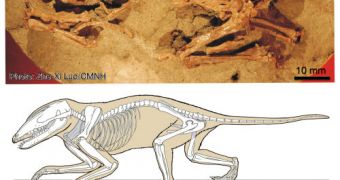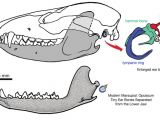Maotherium asiaticus is the name Chinese and American researchers gave to a newly discovered fossil species, which lived in the Liaoning Province of China some 123 million years ago. The chipmunk-sized creature was found in the Yixian Formation, a very rich fossil bed that had yielded countless amazing discoveries over the years. In addition to being completely new, the mammal also holds some clues as to how higher animals developed their middle ears, which are of tremendous importance to hearing as we perceive it. Details of the M. asiaticus appear in the latest issue of the top journal Science.
According to paleontologists, the creature represents an intermediary step in the evolution of the middle ear, and scientists will undoubtedly have a field day studying the fairly well preserved fossil. “With a tiny and intricate middle ear structure, mammals have more sensitive hearing in a wider range of sounds than other vertebrates. This sensitive hearing was crucial for mammals to develop nocturnal adaptations and to survive in dinosaur-dominated times,” NSF Division of Earth Sciences Program Director H. Richard Lane explains.
Zhe-Xi Luo, who is a paleontologist at the Carnegie Museum of Natural History in Pittsburgh, says that, for mammals, hearing is a crucial adaptation to their environment, which allows them to be more aware of incoming or looming danger. Luo has been the author of the Science paper. M. asiaticus was no more than five inches long and had symmetrical rows of teeth, which hinted that it was specialized in eating insects and worms, the experts say. Studies of the remains have also determined that the animal was closely related to the ancestors of marsupials and placentals animals we see living today.
“Mammals have highly sensitive hearing, far better than the hearing capacity of all other vertebrates. According to the Chinese and American scientists who discovered the new mammal, the middle ear bones of Maotherium are similar to those of modern mammals. But unlike modern mammals, Maotherium's middle ear has an unusual connection to its lower jaw. This connection, also known as the ossified Meckel's cartilage, resembles the embryonic condition of living mammals and the primitive middle ear of pre-mammalian ancestors. These mammal middle ear bones evolved from the bones of the jaw hinge in reptilian relatives,” the NSF reports.

 14 DAY TRIAL //
14 DAY TRIAL // 

